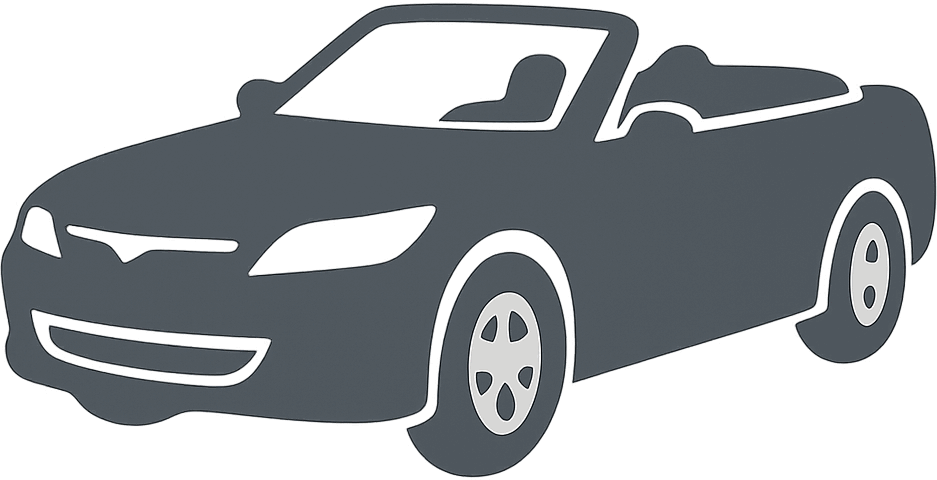 1999 TVR Tuscan Dimensions, Size & Specs
1999 TVR Tuscan Dimensions, Size & Specs
Measurements of the 1999 TVR Tuscan, engineered for optimal performance and comfort
| Dimensions | |
|---|---|
| Length: | 4160-4235 mm163.8-166.7 in13.6-13.9 ft |
| Width: | 1810-1900 mm71.3-74.8 in5.9-6.2 ft |
| Height: | 1200 mm47.2 in3.9 ft |
| Trunk Capacity: | 275 liter9.7 cu ft |
| Weight Specifications | |
| Curb Weight: | 1080-1100 kg2381-2425 lbs |
| Tire Specifications | |
| Tire Sizes: |
|
The TVR Tuscan Cabriolet, produced from 1999 to 2006, is a striking British sports car renowned for its distinctive styling and lightweight design. This generation of the Tuscan features a compact yet aggressive footprint, suitable for both spirited driving and everyday usability. The length varies between 4160 mm (163.8 inches) and 4235 mm (166.7 inches), providing a low-slung stance that emphasizes aerodynamic efficiency and sporty aesthetics. Width ranges from 1810 mm (71.3 inches) to 1900 mm (74.8 inches), contributing to a stable and planted feel on the road, while the fixed height of 1200 mm (47.2 inches) further reduces air resistance and keeps the center of gravity low. Weighing between 1080 kg (2381 lbs) and 1100 kg (2425 lbs), the Tuscan remains exceptionally light for a cabriolet, resulting in agile handling and impressive acceleration. The modest curb weight enhances the driving dynamics, allowing for quick responses and tight cornering capabilities. Despite its sporty focus, the Tuscan provides practical features such as a 275-liter (9.7 cubic feet) luggage capacity, sufficient for weekend trips or sports equipment storage. Tire sizes varied across versions, including 225/50 ZR16, 225/35 ZR18, and 225/45 ZR16, tailored to optimize grip and performance. Overall, the TVR Tuscan Cabriolet stands out as a unique offering in the sports car segment, blending British craftsmanship with raw driving excitement and a carefully balanced size profile.
Discover the standout features that make the 1999 TVR Tuscan a leader in its class
Have a question? Please check our knowledgebase first.
The TVR Tuscan from 1999 to 2006 has an overall length ranging from 4160 mm to 4235 mm (163.8 to 166.7 inches). This length places it right in the middle of typical sports car dimensions from that era, making it relatively compact, which contributes to its agile handling and sporty character. Compared to other sports cars like the Porsche Boxster or Lotus Elise of similar periods, the TVR Tuscan is slightly longer but still maintains a low profile design that emphasizes aerodynamics and performance.
The width of the TVR Tuscan ranges between 1810 mm to 1900 mm (71.3 to 74.8 inches). This relatively broad stance enhances its road presence and stability during high-speed cornering. The wider track width compared to average vehicles improves grip and handling, making it a true driver's car. However, this width means tighter clearance when navigating narrow city streets or parking in confined spaces, so drivers should be mindful of the car's footprint.
The TVR Tuscan has a fixed height of 1200 mm (47.2 inches), which is quite low compared to average passenger cars. This low height significantly lowers the car’s center of gravity, enhancing handling and stability at high speeds. Aerodynamically, the sleek height reduces drag and improves downforce. However, this low seating position can limit outward visibility, especially in traffic or during parking, so the driver should be cautious in tight urban environments.
The curb weight of the TVR Tuscan varies between 1080 kg and 1100 kg (2381 to 2425 pounds). This relatively light weight is a key factor in the car’s strong performance credentials, allowing for quick acceleration and nimble handling. The lightweight construction, typical of sports cars focusing on driving dynamics, means the power-to-weight ratio is optimal, enhancing the overall driving experience by making the car more responsive and agile.
The TVR Tuscan offers a luggage capacity of approximately 275 liters (9.7 cubic feet). For a sports car, this is a respectable amount of storage, sufficient for small suitcases, weekend bags, or daily essentials. While it’s not designed for heavy cargo or long trips requiring substantial luggage, it balances practicality with sporty design well. This capacity makes the Tuscan a feasible option for occasional trips or weekend drives without sacrificing much in terms of sportscar styling and weight reduction.
The TVR Tuscan is equipped with various tire sizes depending on the trim and options: 225/50 ZR16, 225/35 ZR18, and 225/45 ZR16. These wide, low-profile tires contribute to excellent grip and handling characteristics, essential for a high-performance sports car. The different sizes allow for tuning the ride and handling balance, with larger and lower-profile tires enhancing cornering capabilities and responsiveness on the road or track.
With a length between 4160 and 4235 mm (163.8 to 166.7 inches), width of 1810 to 1900 mm (71.3 to 74.8 inches), and a height of 1200 mm (47.2 inches), the TVR Tuscan fits comfortably into most standard residential garages, which typically accommodate vehicles up to around 4800 mm (189 inches) long and 2400 mm (94.5 inches) wide. However, drivers should be mindful of the wider end of the Tuscan’s width spectrum (up to 1900 mm), ensuring there is enough clearance for the garage doors and walls. Its low height also poses no issues for standard garages.
The TVR Tuscan marks a significant evolution over its predecessor, the TVR Griffith. While both cars share the classic TVR ethos of lightweight sports cars with powerful engines, the Tuscan is slightly longer and wider, enhancing high-speed stability and cabin comfort. The Tuscan’s design incorporates more modern styling cues and improved aerodynamics, with a distinctly aggressive and muscular stance. These dimensional updates not only improved performance but also offered better driver comfort and a more refined driving experience than the prior generation.
Dimensionally, the TVR Tuscan sits comfortably in the realm of late 1990s to early 2000s sports cars, with lengths around 4.16 to 4.24 meters, width close to 1.8 to 1.9 meters, and a notably low height. Compared to contemporaries like the Porsche Boxster, Lotus Elise, or Jaguar F-Type models of that time, the Tuscan is generally lighter and wider, emphasizing sharp handling and road presence. Performance-wise, the Tuscan's lightweight construction (1080-1100 kg) combined with powerful inline-six engines results in an exhilarating driving experience that rivals or surpasses many of its peers in agility and raw power.
The TVR Tuscan stands out among convertibles of its era due to its raw, unfiltered driving experience characterized by a lightweight chassis, powerful naturally aspirated inline-six engines, and minimalist approach focusing on driver engagement. Unlike more mainstream convertibles that emphasize comfort and technology, the Tuscan prioritizes performance and emotion with distinctive styling, aggressive exhaust notes, and a lack of electronic driver aids. Its exclusivity, combined with bold design and an exhilarating ride, creates a unique niche for enthusiasts seeking an authentic sports car experience.
